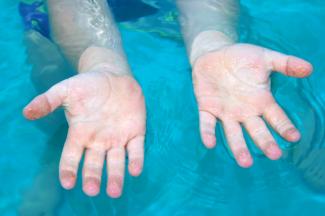
Instructions
Do the preparation task first to help you with the difficult vocabulary. Then read the text and do the exercises below to check your understanding.
Strange fingertips
We are all familiar with the prune-like fingers we get when we are in the bath. Most people think it’s caused by water making the skin in our fingers bigger. In fact it could be an evolutionary feature caused by a reaction in our body’s central nervous system. Rather than the skin getting bigger, fingertips actually shrink when they wrinkle, because the blood vessels inside them contract. The lines could have evolved in our ancestors as they collected food from wet vegetation or streams.
Dr Tom Smulders, an evolutionary neuroscientist at Newcastle University, wanted to test the theory proposed by Mark Changizi in 2011, which said that wrinkled fingers were an evolutionary adaptation. Like treads on tyres, Changizi said that wrinkles served the function of removing water from between the fingers and objects, making it easier to pick things up.
Perfect student project
Smulders saw that it should be easy to prove that wrinkled fingers were better at gripping in wet conditions and it was an ideal student project. He explains, ‘we had the idea of timing how long it takes to move marbles from one container to another, between thumb and index finger. The people in the experiment did that underwater or not underwater, with wrinkled fingers or not wrinkled fingers – so one person did all four conditions.’
They found that people are in fact better at moving objects from underwater with wrinkled fingers than with normal fingers. Smulders said how the original theory was based on the wrinkling as an active process, controlled by the nervous system. People who have damage to their peripheral nerves in their fingers don’t get wrinkles any more.
Adaptation to environment
Whether that means that wrinkled fingers are an adaptation is open to question; it could be a side effect of something that evolved for a different reason. As Smulders explains, ‘it all points towards that it may well be an adaptation for wet conditions, but you can’t prove that from a single experiment; you have to think about many pieces of evidence.’ The research suggests that there may be a loss of sensitivity in our hands, which explains why our fingers return to their normal state when not under water.
Smulders hopes these results will encourage colleagues to continue this research and understand what the evolutionary advantages were for having wrinkled fingers.
If you're interested in science check out the British Council's science magazine called Cubed.
Do you think wrinkled fingers could be an evolutionary adaptation? When is it an advantage to grip things in wet conditions? Share your ideas to help find evidence for this theory.

Comments